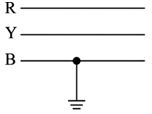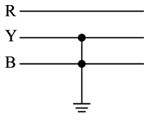An electrical fault is a condition which can cause equipment failures (in transformers, transmission lines, alternators, busbars, etc.) and disturbs the normal working of the system. The faults can also lead to the death of humans, birds, and animals along with equipment failure and electric power supply interruption. Power system protection deals with the protection of equipment in a power system.
Insulation failure and conducting path failures are the causes of electrical fault. These failures can be caused due to
- Lightning
- Heavy winds
- Trees falling across lines
- Vehicles colliding with towers or poles
- Birds shorting lines
- Aircraft colliding with lines
- Vandalism
- Small animals entering switchgear
- Line breaks due to excessive loading
Classification of faults
The faults can be classified as
1. Open circuit faults
2. Short circuit faults
1. Open Circuit faults
The open-circuit faults are caused when there is a break in the conducting path. Due to this the path of current flow in the phases gets interrupted, making the current equal to zero. These faults are also known as series faults. The common causes of these faults include
- joint failures of cable and overhead lines
- failure of one or more phase of circuit breaker
- melting of a fuse in one or more phases
2. Short-Circuit Faults
The short circuit faults is a fault which results in an abnormal connection of very low impedance between two points of different potential, whether made accidently or intentionally. These faults are also known as shunt faults. A heavy current flows in the case of short-circuit faults. This fault is caused due to failure of insulation or conducting path failure. This is by far the most common occuring fault. The common causes of these faults include
- insulator puncture due to lightening or switching surges
- accumulation of dirt or dust or foreign particles on the surface of insulators which result in flashover
- broken conductor falls to the ground
- short circuit of phases
(i) Single-phase to ground fault (LG fault)
When there is a short circuit between one of the phase conductors and the earth, this type of fault is known as Single-phase to ground fault or Line to ground fault (LG fault).

(ii) Two-phase to ground fault (LLG fault)
When there is a short circuit between any two phases and the earth, this type of fault is known as two-phase to ground fault or Double Line to ground fault (LLG fault).

(iii) Phase to Phase fault (LL fault)
When there is a short circuit between any two phases, this type of fault is known as Phase to Phase fault or Line to Line fault (LL fault).

(iv) Three-phase to ground fault (LLLG fault)
When there is a short circuit between three phases and the earth, this type of fault is known as three-phase to ground fault or Triple Line to ground fault (LLLG fault).

(v) Three-phase fault (LLL fault)
When there is a short circuit between three phases, this type of fault is known as three-phase fault or Triple line fault (LLL fault).

Note: Single-phase to ground fault (LG fault), Two-phase to ground fault (LLG fault), and Phase to Phase fault (LL fault) are referred to as unsymmetrical faults.
Note: Three-phase to ground fault (LLLG fault), and Three-phase fault (LLL fault) are referred to as symmetrical faults.
Effects of faults
1. Effects of open-circuit faults
(i) The effect of open circuit faults can lead to the reduction of actual loading of the alternator. This will cause acceleration of alternator and hence it runs slightly greater than synchronous speed. This over speed can cause over frequency.
2. Effects of short-circuit faults
(i) The equipments can be damaged due to overheating caused by heavy current associated with short-circuit faults.
(ii) There may be fire-hazard caused by arcing in the faulty element. There is a chance of spreading of fire to other parts of the system.
(iii) There may be reduction in the supply voltage of healthy feeders.
(iv) There is a heating of rotating machines due to unbalancing of supply voltages and current caused by short-circuit faults.
Order of severity of faults
The Line to ground fault is the least severe fault whereas triple line to ground fault is the most severe fault. The severity of faults increases from top to bottom in the following manner.
LG —— least severe
LL
LLG
LLL
LLLG —— most severe
A three-phase fault is considered as the most severe fault that can occur in the system and hence its short-circuit ratings are used while determining the required switchgear system.
Order of occurance of faults
LG —— 85%
LL —— 8%
LLG —— 5%
LLL & LLLG —— 2%

What resource did you collect your “Order of occurance of faults” from?
How to locate temporary fault of porcelain insulators at 110kv and 220kv line